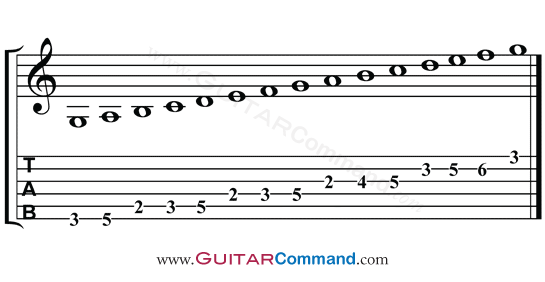This is a guitar lesson on improvisation with the Mixolydian scale. It includes an example solo and backing tracks that you can play along with.
Improvisation With The Mixolydian Scale: Introduction
The Mixolydian scale is a modal scale. It is formed from a major scale, starting and ending on the fifth degree.
- You can find out more about modal scales here: Guitar Modes.
- Learn more interesting scales here: Guitar Scales Master Page.
Many traditional folk melodies are written with the Mixolydian scale. It occurs frequently in Celtic music.
Modal scales are also often used in jazz improvisation. One particular use of the Mixolydian scale is for soloing over dominant seventh chords.
If you find yourself improvising over a 2 5 1 progression, you can use the Mixolydian scale to solo over the 5 chord.
How To Play The Mixolydian Scale On Guitar
One way of playing a Mixolydian scale is shown below. It is a movable shape. Position the green notes over the desired tonic note of the scale. (E.g. start at the 3rd fret to play a G Mixolydian scale.)
G Mixolydian Guitar Diagram

- You can find more ways of playing the Mixolydian scale here: Mixolydian Scale Guitar.
- Don't know what modal scales are: Find out here: Guitar Modes.
Mixolydian Scale TAB & Notation

Mixolydian Scale Theory Tip
One way of thinking about the Mixolydian modal scale is that it's the same as a major scale with the seventh degree flattened.
Notes in a C Major scale: C, D, E, F, G, A, B, C
Notes in a C Mixolydian scale: C, D, E, F, G, A, Bb, C
The flattened seventh note makes the Mixolydian scale a good choice for improvising over dominant seventh chords (e.g. G7 in a C major tune). This is because seventh chords also contain a flattened seventh note.
Example Improvisation Using The Mixolydian Scale
Below is an example of a guitar solo using the Mixolydian scale:
Example Guitar Solo Improvisation With G Mixolydian Scale
The guitar solo is played over this chord sequence:

Notes On This Solo
- For the first two bars, the C major and C pentatonic major scales are used.
- For the second two bars, the G Mixolydian scale is used.
You may have noticed that in fact the C major and G Mixolydian scales use the same notes. However, it's the starting point of the phrases that give each scale its distinctive sound.
Mixolydian Mode Backing Track
Now it's time to play your own solo using the Mixolydian scale.
Improvise over the same chord sequence:

- Try to approach the C major and G Mixolydian parts of the solo separately. Think of the C major scale and the G Mixolydian scale as different scales.
- You can also use a C pentatonic major scale anywhere in the progression for variation.
Backing Track For Improvisation With G Mixolydian Scale
Improvisation With The Mixolydian Scale: Conclusion
We hope that you've enjoyed this lesson and that you're now playing some great Mixolydian licks!
Now you know the scale in one position, you should learn to play it all over the neck. See this page for more Mixolydian scale shapes: Mixolydian Scale.
- You can download a printable guitar scales book here: Guitar Scales Chart.
- If you enjoyed improvising using modes, grab yourself a copy of our specially recorded Guitar Modes Backing Tracks.





Good jazz sound!
Hi, what guitar do you use?
Hi Vai. I used an old Ibanez ES-175 copy.
Nice solo! Cool site!